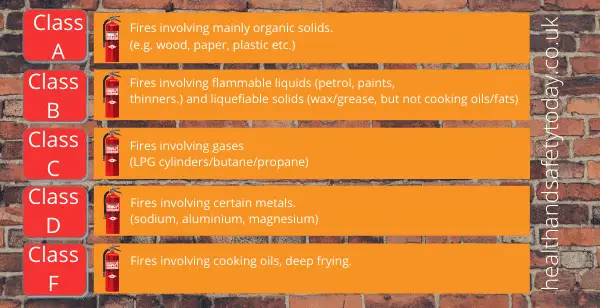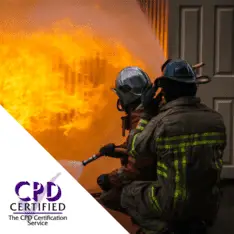Not all fire extinguishers are suitable for all types of fires. What are the different types of fire extinguishers, and what are they designed for?
When choosing an extinguisher, whether for home or work, it’s essential to know.
The Fire Triangle.
Fires need three things to start and burn.
1.) a source of ignition (heat)
2.) a source of fuel (something that burns)
3.) a source of oxygen.
Sources of ignition include heaters, naked flames, electrical equipment, discarded smokers’ materials (cigarettes, matches etc), radiant heat (sun through a window), heat transfer (being next to something already hot), overheating oil from a pan or fryer, or anything else that can get hot or create sparks.
Sources of fuel include wood, paper, plastic, rubber, foam, packaging materials, waste rubbish, furniture, paint, thinners, petrol cans etc.
Sources of oxygen (the surrounding air).
REMOVING ANY ONE OF THESE ELEMENTS WILL EXTINGUISH THE FIRE.

How fire extinguishers work?
Portable fire extinguishers use a variety of media (contents) to extinguish different types of fires.
Principally, these are –
- Water.
- Foam.
- Dry Powders.
- Special Powders.
- Carbon Dioxide.
- Wet Chemical.
- Vaporising Liquids.
Their mode of action is based on the fire triangle –
COOLING (to remove the heat)
SMOTHERING (to starve the fire of oxygen)
Remember, by removing any one of the elements in a fire triangle you will not have a fire.
Fire classifications.
In the UK, there are 5 primary classifications of fire. (Some say 6, but we will clarify that in a moment), and your extinguisher needs to be suitable for the area you intend to protect.
- Class A. Fires involving mainly organic solids (paper, wood, plastic etc)
- Class B. Fires involving a flammable liquid. (petrol, oil, paints) This also includes liquefiable solids (waxes, grease, fats – but not cooking oil or cooking fat).
- Class C. Fires involving gases (liquid petroleum gas-LPG, butane and propane)
- Class D. Fires involving certain metals (magnesium, sodium, aluminium).
- Class F. Fires involving deep fat/oil fryers.
You will notice that Class E has been skipped over. This is because this classification was for electrical fires.
Although certain types of extinguishers can be used on electrical fires, it requires a level of knowledge and training to understand the dangers of electrical fires and what can and cannot be used.
For example, using a water filled CLASS A extinguisher on an electrical fire could be fatal to the fire fighter, as water and electricity don’t mix.
Other classifications of extinguishers also contain a level of moisture content, which again could transfer electricity over to the user.
The general advice for electrical fires is to isolate the electric supply first by either unplugging the cord at the power point if it can be reached, or switching off at the fuse box.
Once the appliance has been isolated from the electrical supply, then it can be extinguished as any other type of fire, usually a CLASS A.

What are the different fire extinguishers?
Fire extinguishers have different contents (media) suitable for the different classifications of fire.
Water fire extinguisher
Pros of a water filled fire extinguisher.
- Most suitable for Class A fires.
- Cheapest of all extinguishers and most readily available.
- Rapid cooling of the burning material which will extinguish the fire and prevent re-ignition from high heat.
Cons of a water filled fire extinguisher.
- Small jet of water so limited coverage and reduced throw.
- Cannot be used on live electrical equipment, flammable liquids, or oil/grease and fat.
- Excess or surplus use may cause water damage to property, furnishings, equipment etc.
Foam fire extinguisher
Pros of a foam filled fire extinguisher.
- Suitable for Class B fires and can be used as a Class A substitute.
- Good properties to stop the fire re-igniting.
- Works by forming a layer on top of the burning liquid, both smothering the flammable vapour and blocking out oxygen.
Cons of a foam filled fire extinguisher.
- The contents can freeze easily so unsuitable for cold locations.
Dry powder fire extinguisher.
Pros of a dry powder fire extinguisher.
- Suitable on Class A, B and C fires.
- Can also be used on live electrical equipment due to having no moisture content. (always try to isolate electrical equipment in the first instance where possible)
- Has the capability to extinguish a fire more rapidly than foam.
- Works by smothering the fire and also chemically inhibiting combustion.
Cons of a dry powder fire extinguisher.
- Offers little cooling so a fire may re-ignite.
- Leaves a lot of residual mess.
- Can obscure vision, especially in a small or confined area.
- Possibility to aggravate medical conditions such as asthma and other respiratory conditions.
Special dry powder fire extinguisher
Pros of a special dry powder fire extinguisher.
- Chiefly developed for use on Class D metal fires.
- Different powders are available depending on the metal
Cons of a special dry powder fire extinguisher.
- Operator needs to be specially trained.
co2 fire extinguisher
Pros of a co2 fire extinguisher.
- Good for live electrical appliances as the gas can penetrate the equipment.
- Also suitable for smaller Class B fires.
- Works by smothering and displacing the oxygen. (i.e. it is a heavier gas than oxygen so pushes it down and out of the area.)
- Does not cause residual damage.
Cons of a co2 fire extinguisher.
- Little or no cooling effective so re-ignition of the fire is a risk.
- Oxygen is depleted in the discharge area, so may cause asphyxiation in a confined space.
- Gas discharge can be very noisy causing alarm to an inexperienced user.
- The user needs to get relatively close to the fire for maximum effectiveness.
- Limited results if used externally as the gas dissipates quickly into the atmosphere causing the risk of re ignition.
- The discharge horn can get ice-cold very quickly.
Vaporising liquids fire extinguisher.
Pros of a vaporising liquids fire extinguisher. (also known as Halotron)
- Safe on Class A and Class B fires.
- Also effective on live electrical and electronic equipment, particularly electronic areas such as computer rooms, telecom and clean rooms.
- Has little environmental impact and leaves no residual mess.
- Works by releasing a heavy vapour which excludes oxygen and interrupts the combustion process.
Cons of a vaporising liquids fire extinguisher
- Price and sometimes availability in the UK.
- Developed to replace the ozone depleting Halon extinguishers formerly used to protect electronic systems. Halon is now illegal in the UK apart from specialist installations such as military and the Channel Tunnel for example.
Wet chemical fire extinguisher
Pros of a wet chemical extinguisher.
- Developed for Class F fires where cooking fat/oils have ignited.
- Reduces the risk of re-ignition.
- Works by laying an alkaline solution over the burning oil that produces a soapy layer trapping the hot vapour, excluding oxygen and providing some cooling.
Cons of a wet chemical extinguisher.
- Expensive to initially purchase and have refilled. (See update on an affordable home version and availability)
Types of fire extinguishers | How to identify.
All common types of fire extinguishers in the UK are colour coded for quick identification.
The body of the extinguisher is always coloured red, with a further identifying colour coded label, depending on what the contents are.
Colours of fire extinguishers.
- RED LABEL. Contents Water.
- CREAM LABEL. Contents Foam.
- BLACK LABEL. Contents Carbon Dioxide (Co2)
- BLUE LABEL. Contents Dry Powder.
- YELLOW LABEL. Contents Wet Chemical.
- GREEN LABEL. This was used for the now banned Halon extinguishers.

What does a fire blanket do | Are they a good alternative?
A fire blanket is a flame-resistant blanket that can be used to extinguish a small fire. Typically this will be in a kitchen where a pan containing hot fat or oil has flared up.
Fire blankets are fabricated from 2 layers of woven glass fibre with an inner fire retardant film.
Pros of a fire retardant blanket.
- Suitable for fat or oil fires.
- Cheap to purchase and have no shelf life.
- Compact and unobtrusive.
- Can be used to wrap around a person to dowse flames.
- Works by smothering the fire and excluding oxygen.
Cons of a fire retardant blanket.
- Risk of the fire re-igniting as there is no cooling effect.
- Need to be well sited as it has to be readily available (no hunting through drawers or in the back of a cupboard)
- Fire fighter should be familiar with how to place the blanket over the fire so as not to risk personal injury. (This method involves getting close to the fire)
Further reading.
Best Fire Extinguishers For Home
How to carry out a fire risk assessment in the workplace. 5-Steps to a Fire Risk Assessment.



4 thoughts on “What are the different types of fire extinguishers”